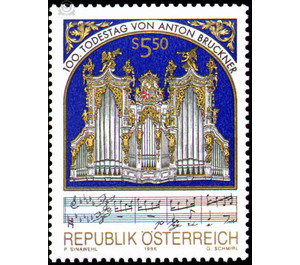100th anniversary of death - Austria / II. Republic of Austria 1996 - 5.50 Shilling
Theme: Art & Culture
| Country | Austria / II. Republic of Austria |
| Issue Date | 1996 |
| Face Value | 5.50 |
| Color | multi-colored blue |
| Printing Type | combination printing |
| Stamp Type | Commemorative |
| Item Type | Stamp |
| Chronological Issue Number | 1527 |
| Chronological Chapter | OOS-OE2 |
| SID | 4188 |
| In 64 Wishlists | |
Austria's cultural world significance in music, founded by Haydn, Mozart and Schubert, was expanded in the second half of the 19th century with the life work of Anton Bruckner. Austria honors this brilliant musician with a special stamp showing the famous Bruckner organ in St. Florian. Bruckner was born on September 4, 1824 in Ansfelden near Linz. After the early death of his father, the Augustinian Monastery St. Florian took him on as a choirboy. The spacious and light-flooded architecture of the magnificent baroque building was the archetype of the sound architecture of his symphonies. Until his position as Linz cathedral organist Bruckner was a self-taught musician, and only years later he successfully completed the studies of counterpoint with Simon Sechter at the Vienna Conservatory. In his 40th year Bruckner wrote his first great masterpiece, the D-minor Mass. Her success led him to the famous Brass Mass in E minor, anticipating the reform of church music. Between these church music works Bruckner composed two symphonies in which he tried to expand Beethoven's symphonic form. He himself, however, first let his third symphonic work be considered his first symphony. However, this went far beyond the comprehension of his contemporaries and the success remained modest. As with most geniuses, it took some time for his work to find the understanding needed for lasting recognition. Today, it is clear that Bruckner was ahead of his time, for he understood it like no other, to expand, to perfect and perhaps even to surpass Beethoven's symphony form.


